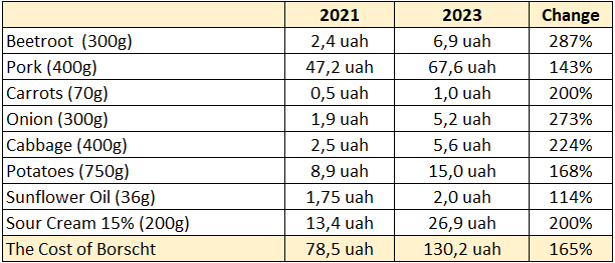There are three things you can watch forever: fire burning, water flowing, and someone counting crisp bills. True, we are talking about income, not expenses, because no matter how much you earn, it is always harder to give than to receive.
Nevertheless, I suggest that we calculate together how much the cost of living in Ukraine has increased since the beginning of the Great War, using the Borscht Index — the average cost of preparing a dish according to a classic recipe.
Why borscht?
Getting ahead of the question, I will say: borscht has been considered a cult Ukrainian dish since ancient times, which is prepared in almost every home. Even tourists come to us from other countries, including to try it. And no, Russia has nothing to do with our borscht! The fact that on July 1, 2022, UNESCO included borscht on the list of intangible cultural heritage of Ukraine is further proof of this.
In addition, borscht consists of many products, including potatoes, meat, beets, carrots, cabbage, oil, etc. That is why this dish perfectly demonstrates the real level of inflation in the country.
Borscht Index: Prices for cooking at home
First, let's figure out how to cook borscht, because each region, and every housewife, has their own recipe. In order not to offend anyone, we will take as a basis the recipe for classic borscht, published by Yevhen Klopotenko, a famous Ukrainian chef who initiated the inclusion of borscht on the UNESCO Intangible Cultural Heritage List:
- 300 g beetroot
- 400 g pork (shoulder)
- 1 carrot
- 3 onions
- 400 g white cabbage
- 5 potatoes
- 3 tbsp sunflower oil
- 200 g sour cream
We will replace the borscht dressing in the recipe with beets, and we will not take into account the water and 4 peppercorns, because they cost a penny.
Let's move on to analyzing the prices of these products (for convenience, I have converted the artificial indicators into grams using average values):

Data on the cost of products for 2023 was obtained from the Silpo online store, and for 2021 - from the Ministry of Finance website (they are based on monthly summaries published on the official website of the State Statistics Service of Ukraine).
What is the result? The cost of cooking borscht has increased by 1.6 times, that is, almost twice. The most noticeable changes were in the cost of beets and onions (almost 3 times), cabbage (2.2 times), as well as carrots and sour cream (2 times). Let me remind you that inflation in Ukraine in 2022 was 26%, and in 2023 - 7%. A bit far from how this affected the cost of our borscht, right?
The thing is that when calculating the annual inflation rate, completely different indicators are taken into account than the prices of products in ATB or Silpo. Although the official inflation rate was 7%, it is felt at a full 177%, because the salary also adds fuel to the fire: the “minimum” in 2021 was 6,000 UAH, while at the end of 2023 it was 6,700 UAH. If converted into percentages, this is a 111% increase in 2 years. As we can see, prices are growing much faster than the salaries of most citizens.

As we can see, on average, prices for Ukrainian borscht in catering establishments have increased by 151%, or 1.5 times, in 2 years.
If we compare borscht at home and borscht in an institution, in 2023 the home version cost 130 UAH (for a 3-liter pot), and a serving of the dish (200-300 ml) outside the home cost an average of 77 UAH.
I am in no way discouraging anyone from eating out! But at the same time, I can't help but show you how much you can save by making borscht in your own kitchen.
As for the percentage increase in the price of the dish, the data here coincides: both homemade and restaurant borscht have increased by 150-160%.
Why are prices rising so quickly?
Here are several factors that significantly affect the rise in prices (in particular, our borscht):
- Occupation of agricultural regions;
- Mining of territories;
- Crop failures;
- Disrupted supply chains;
- Rising energy prices;
- Devaluation of the hryvnia due to the war.
Let's analyze all this with a simple example, as they say, "on the fingers". The prices for tractors and combines have increased, and tractor and combine operators have joined the ranks of the Armed Forces of Ukraine. The number of workers in the industry has decreased sharply, and the shortage of personnel, which is noticeable for the agricultural sector, has affected the amount of products produced - it has become less. In order to attract new workers and reduce the shortage of personnel, it is necessary to increase salaries. The costs of the arable producer are growing not only because of salaries, but also due to other factors: premises that are destroyed as a result of "arrivals", fields with crops that are damaged as a result of hostilities, logistics that are changing and becoming more expensive, the cost of fertilizers and fuel, spare parts and new equipment - as we can see, the costs of producing products are only growing. And, of course, this cannot but affect its price.
And what to do?
Borscht is not a cheap dish, but it is very tasty. Calculations have shown that the cost of both restaurant and homemade borscht has increased by 150-160%, which is more than 1.5 times.
And although no one has been able to stop the rise in prices in Ukraine, you can still save money here. For example, if you give up meat and cook lean borscht, which is no less delicious. Or if you eat from your own kitchen, not a restaurant.
And where to direct your savings? I'm sure everyone has a lot of options. But I'll still mention the most popular ways of investing money among Ukrainians:
- Donate tirelessly to support the Armed Forces of Ukraine;
- Open a deposit to protect your money from inflation.
Or do both, if your wallet allows.










